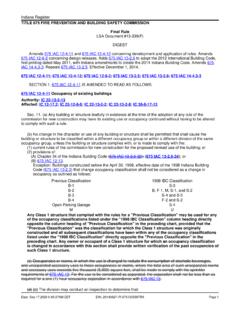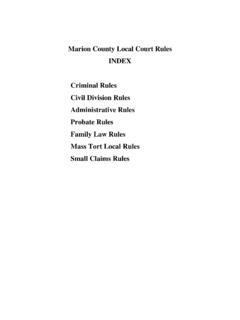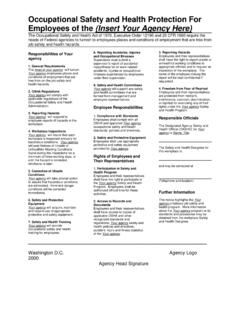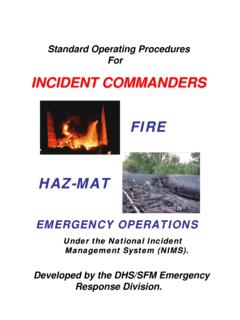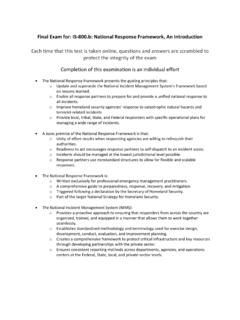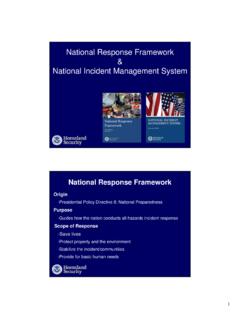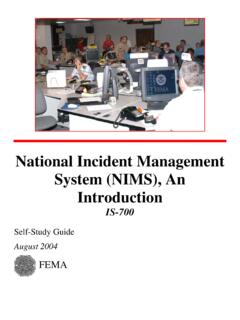Transcription of Navigating National Incident Management System …
1 Navigating National Incident Management System training requirements Joe Wainscott The indiana Department of Homeland Security has received many inquiries during the past months regarding the levels of training required for NIMS compliance. Many questions center around how best to determine who should attend which level of training to be compliant. Keep in mind there are several components affecting NIMS compliance, in this article we are going to focus solely on the training issues associated with the NIMS program guidance. The indiana Department of Homeland Security does not require NIMS compliance from any indiana public safety agency. The requirements come from the federal level and are enforced through grant funding qualifying standards and through adoption of performance standards such as those established by OSHA.
2 Background We should first look at the legal issues associated with NIMS compliance. USDHS Homeland Security Presidential Directive 5 (2-28-2003) set the direction for the nationwide implementation of NIMS for the federal government. Federal Occupational Safety and Health Administration (OSHA) requirements under 29 CFR and compliance directive CPL:02-02-073, dated 8-27-2007, have established the requirement that the Incident Command System be used during incidents covered by these directives be NIMS compliant. This also applies to EMS personnel and First Receivers in hospital departments. Governor Daniels has directed state agency compliance to NIMS in Executive Order 05-09. It is important to note that while local agencies are not legally bound to comply with NIMS metrics, it is a requirement to receive federal or state public safety related funding.
3 Additionally, with the adoption of NIMS compliant Incident Command procedures by OSHA, we recommend that departments consult their legal advisor about any potential liability that may be incurred by failing to become NIMS compliant and properly implementing the approved Incident Command System . Federal Fiscal Year 2006 grant requirements called for states and local jurisdictions to adopt NIMS by executive order, proclamation, resolution, or legislation. During that period, the State of indiana and every indiana county agreed through some type of documentation that they have complied with this requirement. The FFY2007 NIMS compliance included the completion of IS-700, ICS-100 and ICS 200 as a Tier 1 requirement (mandatory) for the appropriate level of personnel specified in the guidance.
4 These requirements were defined as Tier 1 or required for compliance. Tier 1 metrics and questions were deemed critical to measuring FFY07 compliance. The Tier 1 metrics are derived from previously established NIMS requirements and are fundamental to the success of NIMS implementation. The NIMS five year training plan (based on the latest NIMS Alert Bulletin, 12-3-07), published by the NIMS Integration Center, shows that the completion of ICS-300 is scheduled to be Tier 1 requirements for FFY2008. ICS 400 is now a FFY2009 requirement. This changes the previously published information that required both to have been completed by the end of this fiscal year. Remember that the guidance indicates that ICS-300 is required for middle and upper Management and ICS-400 for those serving in Command and General Staff positions, not for everyone in your agency.
5 Discussion IDHS has the following suggestions for local departments as they address NIMS compliance training issues: Each department has the responsibility to self-select, self-certify, and self-regulate which of their personnel attends which level of training . Much like OHSA compliance, NIMS compliance and justification is the responsibility of the department (employer). So the department head has the responsibility (and potential liability) for identifying which staff member needs to complete which level of ICS training . The department head is also responsible to be able to justify those decisions if challenged by USDHS or OSHA. Agency heads must be aware of the types of incidents their personnel are trained to handle and be prepared to require the hand off of command at incidents they are not trained to handle.
6 Just as EMS protocol requires that a responder hand off patient care to someone with a higher level of training and capability, ( , an EMT-B turns over patient care to a Paramedic), an Incident Commander should turn over command authority to one more qualified when they arrive on scene if, and when, the circumstances of the Incident dictate the need for a more highly trained and qualified Incident Commander. The Incident Commander also has the responsibility to call in properly trained personnel if the Incident exceeds their level of training and capability. Incidents have been classified under NIMS typing as follows (note the ICS 300 level requirement takes effect October 1, 2008 and the ICS 400 level requirement does not take effect until October 1, 2009): Type 5 Under one operational period, minimum resources, the only ICS position staffed is the Incident Commander ( , single vehicle crash, car fire, missing person search, limited HazMat spill) ICS-100, ICS-200, and IS-700 apply to the Incident Commander and all first responders and disaster workers must have ICS-100 and IS-700, first line supervisors must have ICS-100, ICS-200, and IS-700.
7 Type 4 Limited to one operational period, command and general staff positions activated as needed ( , structure fire, protest rally, barricaded suspect, incidents requiring multi-agency response, significant HazMat spill). ICS-100, ICS-200, and IS-700 apply to the Incident Commander if no Command and General Staff positions are filled. ICS-300 and ICS-400 will apply to the Incident Commander and to those filling Command and General Staff positions if and when any Command and General Staff positions are activated. Type 3 May extend into multiple operational periods, some/all command and general staff positions activated ( , large industrial fire, tornado, hostage stand-off).
8 ICS-100, ICS-200, ICS-300, ICS-400, IS-800 and IS-700 will apply to the Incident Commander and to those filling Command and General Staff positions. Type 2 Multiple operational periods, many command and general staff positions filled, state, regional and/or National resources brought in ( , devastating flood or earthquake). ICS-100, ICS-200, ICS-300, ICS-400, IS-800 and IS-700 will apply to the Incident Commander and to those filling Command and General Staff positions. Type 1 Expected to go into multiple operational periods, event of National significance ( , major terrorist attack like 9/11 or Katrina level disaster). ICS-100, ICS-200, ICS-300, ICS-400, IS-800 and IS-700 will apply to the Incident Commander and to those filling Command and General Staff positions.
9 Risk Management Those who serve in positions of leadership in public safety have an obligation to give due diligence to the reduction of risk to their subordinates safety and the potential exposure to liability for their department and governmental entity. According to Wikipedia, Risk Management is the human activity which integrates recognition of risk, risk assessment, developing strategies to manage it, and mitigation of risk using managerial resources. The strategies include transferring the risk to another party, avoiding the risk, reducing the negative effect of the risk, and accepting some or all of the consequences of a particular risk. Some traditional risk managements are focused on risks stemming from physical or legal causes ( natural disasters or fires, accidents, death and lawsuits).
10 Application of risk Management principles to our navigation of the Incident Command System and the requisite training associated seem to lead us to these conclusions: If an Incident Commander does not hand off command when not qualified to handle an Incident , the Incident Commander could impair response efforts and could expose their agency, and governmental entity to liability for things that go wrong or other failures (such as being fined by OSHA or even being subject to a civil lawsuit). If a department does not have anyone trained to the ICS-300 and ICS-400 level, then they are not qualified to manage a Type 4 if any Command and General Staff positions are activated, Type 3, Type 2, or Type 1 Incident under the NIMS guidelines.
